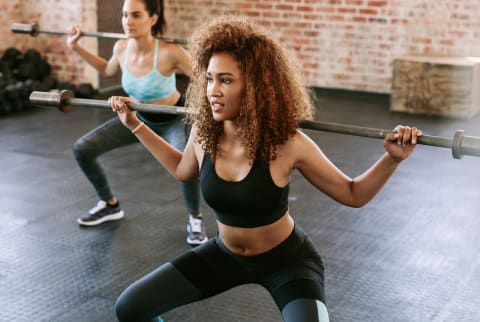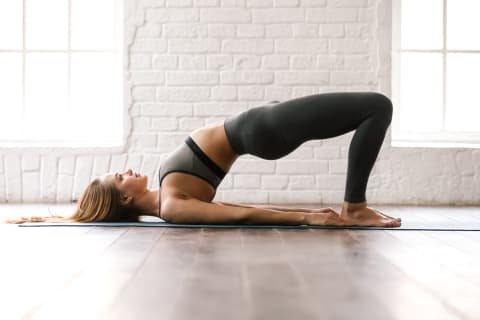Advertisement
What Exactly Is Eccentric Exercise? Trainers & Physical Therapists Break It Down


Eccentric exercise is not, as it may sound, an unconventional type of workout (although, those are great, too). It actually describes the lengthening portion of a strength training movement. Whereas the shortening phase is concentric exercise. (Think: the lifting or lowering of your arm in a biceps curl.)
While both phases, or types, of exercise are valuable, most people tend to pay less attention to eccentric movement (be honest: You've let your arm drop at the end of a biceps curl rep)—which can lead to injury. To better understand the benefits and potential risks of improper eccentric muscle contraction, mbg reached out to fitness trainers and physical therapists.
What is eccentric muscle contraction?
Eccentric muscle contractions describe the lengthening or lowering phase of exercise. This process is also referred to as negative work1 since the muscle is absorbing energy from an external load, one study explains.
"Eccentrics, in a nutshell, is the art of lowering a weight as slowly as you can," says Antonio Lombardo, P.T., DPT, physical therapist at Professional Physical Therapy.
Nearly all lowering motions in a strength exercise, like the downward motion of a squat, the downward motion of a pushup, the downward motion of a biceps curl, are examples of eccentric muscle contractions, ACE-certified personal trainer Stephanie Thomas, tells mbg. "To work the eccentric phase of an exercise, you want to concentrate on the motion and perform it slowly," she adds.
Benefits of eccentric exercise.
There are plenty of benefits of eccentric exercise, including:
Building strength.
While it may seem like the restorative part of an exercise, eccentric muscle contraction is equally essential in building strength. "Since our muscles need to be able to stretch and shorten with control over various loads, it's important not to overlook building that aspect of strength," says NASM-certified personal trainer BB Arrington.
Working the negative phase of an exercise helps the muscle become stronger, Thomas adds, which may make it increase in size faster.
Injury prevention.
Because it feels like the release or the resting phase, some people overlook eccentric contraction. However, this is where most injuries occur, Arrington says. So it's a wise move to be more mindful and slow down during this part of your routine.
Better balance.
Studies have shown that elderly people who engage in eccentric exercises2 are better able to complete functional tasks and less likely to fall. Another study on 21 elderly men, aged 80 on average, found that those who participated in eccentric exercise saw a 60% improvement in strength, 7% improvement in balance, and 21% improvement in stair descent abilities3.
Eccentric vs. concentric exercise.
"In an exercise that involves a range of motion—not a static hold like a plank—the muscles undergo a shortening and lengthening phase," Arrington previously told mbg. "The shortening phase is called the concentric phase; the lengthening or lowering phase is called the eccentric phase."
Concentric movements are more effective at increasing maximum power output (aka the ability to exert more energy in a short amount of time), Danielle Gray, NASM-CPT, and founder of Train Like a Gymnast, previously said, whereas, eccentric movements are thought to cause more micro-tears in muscles, which is necessary for building muscle.
Eccentric moves to try.
For the upper body:
1. Lowering into a pushup
How to do it: Start in a plank position, with your hands directly underneath your shoulders, lower slowly and with control; hover with your chest above the ground (pictured above).
2. Lowering the arms during a biceps curl
How to do it: After raising the dumbbell up to your shoulders during a biceps curl, slowly lower the weight back down to your side.
3. Lowering down from a pull-up or chin-up
How to do it: After your chin has raised above the bar (in either a chin-up or a pull-up), begin to straighten your arms as you lower down, slowly and with control.
For the hamstrings:

1. Supine hamstring walkouts
How to do it: Start in a bridge position (pictured above); with your weight on your heels, begin walking your feet away from your body. Once your feet are as far away as they can get without sacrificing the correct form, begin walking them back toward your body.
2. Supine hamstring slide-out (unilateral or bilateral)
How to do it: Start in a bridge position; place a hand towel or sliders underneath your heels. With your weight on your heels, slowly slide your feet away from the body. This is similar to the walkouts, but you're sliding instead of walking. You can do this move unilaterally (with one foot) or bilaterally (with both).
3. Nordic drop
How to do it: Begin in a kneeling position; have someone hold your ankles for added support; cross your arms in front of your chest and slowly begin leaning forward with your back straight. Note: This move is challenging and may take practice to build up to (reverse Nordic drops are a bit easier, according to Arrington).
For the quads:
1. Slow lower to reverse lunge
How to do it: Begin standing with your feet hips-width apart with a straight spine and tailbone slightly tucked. Step the left foot back, coming into a reverse lunge. On the ball of your left foot, lower your knee so it's just hovering above the ground (do this part slowly.) It's OK to lean slightly forward during the lunge.
2. Reverse Nordic drop
How to do it: Start in a kneeling position, with your arms crossed over your chest; slowly lean backward, keeping your back straight.
Risks and safety.
Because it's often overlooked, sometimes people will injure themselves while doing eccentric exercise. Clients tend to do the minimum work possible to lower the weight instead of contracting the muscle slowly and with control, Arrington says. This can lead to injury from improper form.
"If there is a notable weakness or lack of coordination during eccentrics, a bit more effort and attention to that area would be greatly beneficial," she says. It's also important to note that eccentric exercise tends to leave people more sore than concentric exercise because it causes muscle damage (essential for muscle building).
"The increase in soreness can discourage [beginners] from continuing with their workout program, as muscles can remain sore for several days after an exercise," Thomas says. While soreness in and of itself is not a bad thing, if it keeps you from being active, it may be best to limit eccentric exercise to fewer days of the week and consider cross-training with light walks, yoga stretches, or other soothing physical activities. "With proper rest, hydration, and sleep, you'll be back on your feet just in time for your next workout," Lombardo says.
The bottom line.
Both concentric and eccentric muscle contractions are equally important for strength training. Eccentric exercises, though often overlooked, should be practiced with control to prevent injury. With proper form and technique, these lengthening movements help promote balance, reduce injury, and increase strength.
Watch Next
Enjoy some of our favorite clips from classes
Enjoy some of our favorite clips from classes
What Is Meditation?
Mindfulness/Spirituality | Light Watkins
Box Breathing
Mindfulness/Spirituality | Gwen Dittmar
What Breathwork Can Address
Mindfulness/Spirituality | Gwen Dittmar
The 8 Limbs of Yoga - What is Asana?
Yoga | Caley Alyssa
Two Standing Postures to Open Up Tight Hips
Yoga | Caley Alyssa
How Plants Can Optimize Athletic Performance
Nutrition | Rich Roll
What to Eat Before a Workout
Nutrition | Rich Roll
How Ayurveda Helps Us Navigate Modern Life
Nutrition | Sahara Rose
Messages About Love & Relationships
Love & Relationships | Esther Perel
Love Languages
Love & Relationships | Esther Perel











